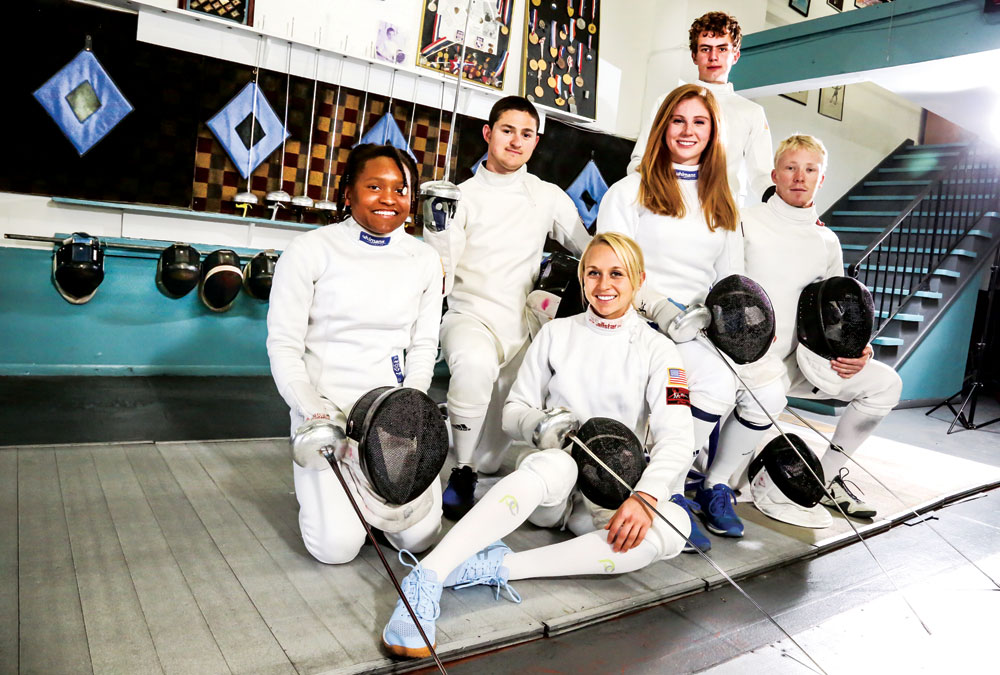
Clockwise from left: Naomi Ross, Issac Neivert, Avery Niemann, Henry Shugart, Seamus Millet and Samantha Achterberg are training to be pentathletes at Cheyenne Fencing.
“The pentathlon is the only sport that was created for the Olympic games,” says Elaine Cheris, a former Olympic fencer who trains pentathletes. “It’s a crazy combination of sports that couldn’t be more different from each other.”
Cheris has trained pentathletes and fencers for competition since 1981 at her Cheyenne Fencing and Modern Pentathlon Center on East Colfax Ave. in the Montclair neighborhood. The pentathlon is five sports done consecutively: fencing, swimming, riding, shooting and running. Running laps alternate with pistol-shooting rounds. “The running and swimming events are about speed, while shooting the laser pistol requires absolute calm. Fencing is the skill sport,” said Cheris.

Avery Niemann (right) lunges toward Samantha Achterberg during a practice session.
Avery Niemann, 20, Cheris’ newest pentathlon trainee, is on the swim team at Denver University. She’s also familiar with English horseback riding and shooting because she grew up vacationing on the family farm in Oklahoma. She began fencing and running last year at Cheyenne Fencing. “Deciding to train for the pentathlon has meant commitment and perseverance,” Niemann said.
“The young people who stick to it and don’t get discouraged will be successful,” Cheris said. “Hard work is the key, even if someone is not the most coordinated athlete. It helps to remain unfazed by success or failure.”
Cheris knows something about competing against the odds. She was a competitive athlete in swimming and running in college and started fencing late in her athletic career. “At age 29, I was twice as old as some of my competitors.”
Cheris, a Park Hill resident, competed on the U.S. Olympic fencing team in 1980, 1988 and 1996. She was on the Pan American Games fencing team [for all nations of the Americas] from 1987-1991; the team won in 1987 and 1991. She would have been a candidate for the Olympic pentathlon, but women’s pentathlon was not a part of the Olympics until the 2000 games.
Niemann decided to train for the 2020 Olympics in Tokyo while watching the pentathlon in the 2016 Rio de Janeiro games. “I realized I was only one second behind the world record for swimming in the event. I started fencing twice a week at Cheyenne Fencing and Elaine said, ‘You could be good at this.’”

Avery Niemann practices her riding, one of five sports that pentathletes need to master.
Niemann, a junior in biology/pre-med, decided to start training full time for the Olympics in June 2017. “When I asked my parents about it, I was panicking a little. But they have been incredibly supportive. This is a different direction than I ever pictured, but I’ll have eight more years of med school after I finish my degree. My parents said, ‘You can go to school anytime, but you can’t go to the Olympics anytime.”
Niemann competed in pentathlon at the World Cup in Egypt this February. “I’m getting experience competing in events other than swimming. Overall I have lots to do on fencing and running.”
She calls her odds of making the Olympic team “incredibly small.” “Other people have been fencing for eight or 10 years, as long as I’ve been swimming. It’s scary to put everything on the line for something.”
Cheris has trained thousands of athletes, many from the beginner level, including several that went to the Olympics. Current Olympic hopefuls at her gym include Naomi Ross, 18; Seamus Millett, 19; Hannah Priddy, 14; Henry Shugart, 15; and Samantha Achterberg, 25.
“These kids are all about the Olympics; it is their number one aspiration,” Cheris said. “People have to want this, and to hunker down every day. I tell them to ask themselves ‘What am I doing today to make the Olympic team?’ If they injure an arm, they work on their legs. If they break something, they work on their mental attitude. You need a passion for it. You can’t do it for publicity.”
Besides coaching pentathletes, Cheris also teaches fencing to children of all ages. “Fencing is a great sport for kids who don’t do football or the other usual sports,” she said. “In fencing, your size doesn’t matter. Fencers are usually very smart because they can go straight from seeing the situation to making the right move; there’s no time to think. It’s great for kids who are bored in school.”

Elaine Cheris, owner of Cheyenne Fencing, with one of her three parrots on her shoulder, works on form in front of a mirror with Samantha Achterberg (far left) and Avery Niemann.
Cheyenne Fencing’s community vibe includes the presence of a variety of rescued birds, rabbits and dogs. “I can’t say no to taking an animal if it’s injured or in danger of being put down,” said Cheris.
The menagerie includes ducks, chickens, a pigeon that does tricks and a crow that Cheris rescued after it was hit by a car. A conure (a type of parrot) entertains by hanging upside down in its cage and doesn’t mind being petted. “Kids come in here who are scared to death. I put a rabbit in their lap and it calms them right down,” Cheris said.



0 Comments